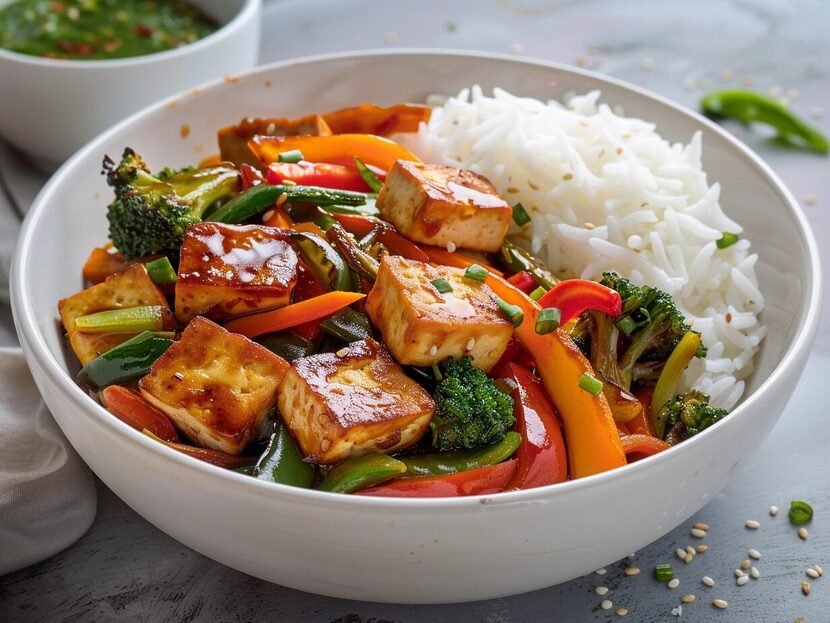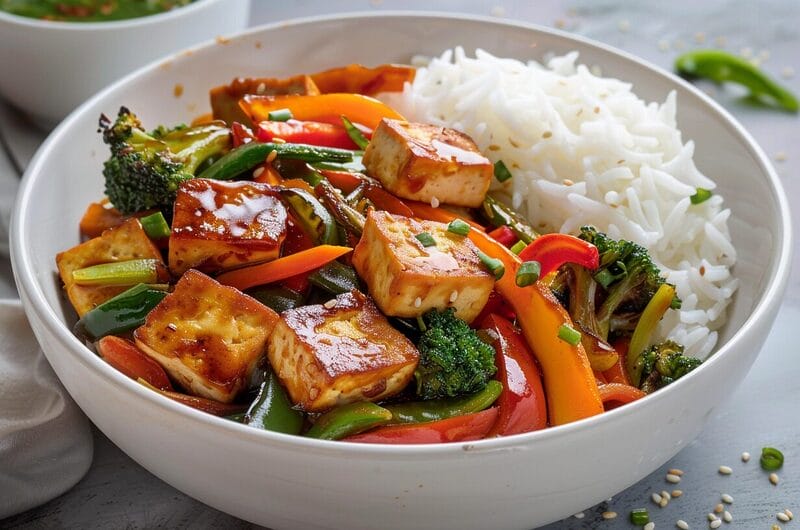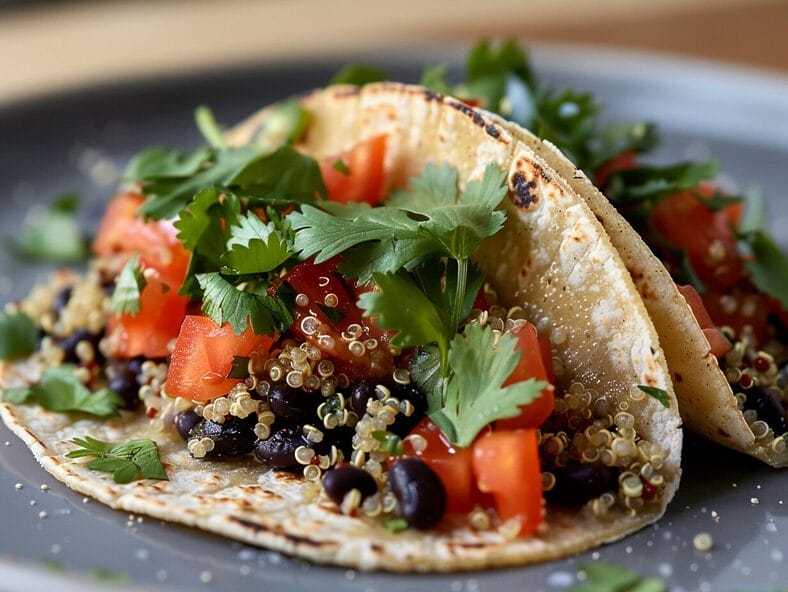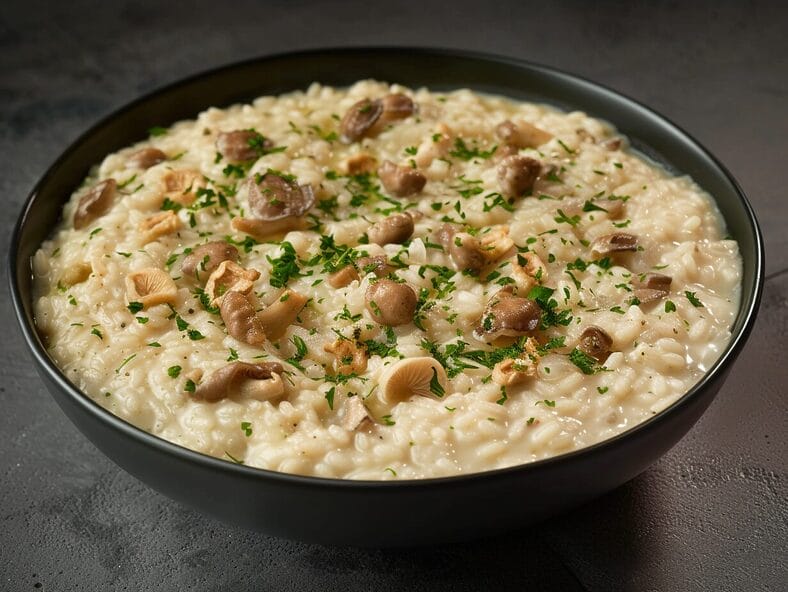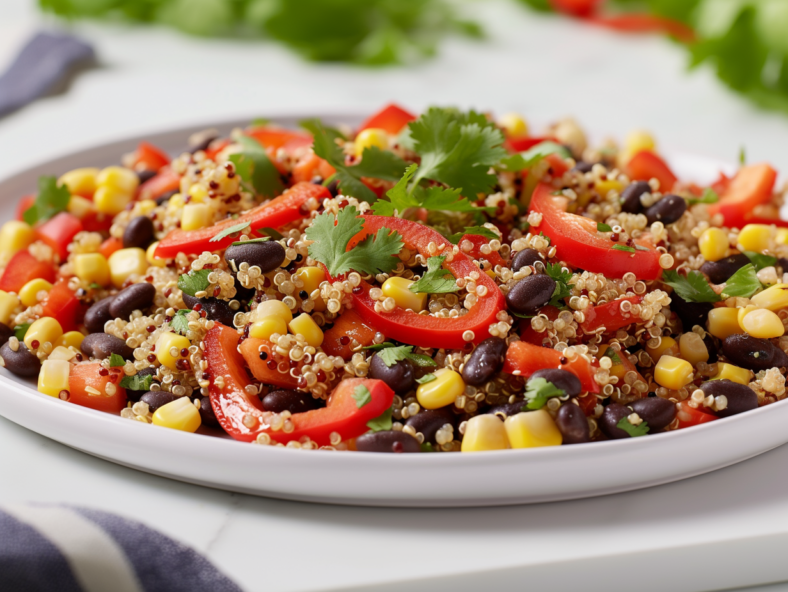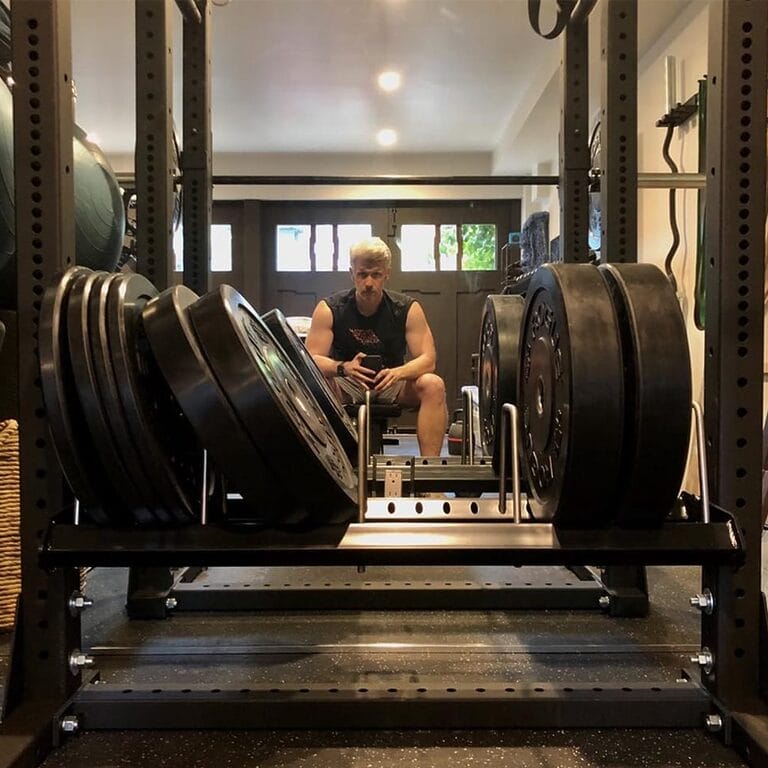Get ready to enjoy a vibrant and wholesome dish that brings together the best of plant-based eating. This Baked Tofu and Vegetable Stir-Fry is a go-to at our house because it is customizable and super easy to prepare (more on that below). The tofu is baked to perfection, giving it a delightful crispness, while the vegetables are stir-fried to maintain their natural crunch and flavor. This dish is inspired by the Blue Zone principles of eating whole foods and plant-based meals for longevity and overall health. Keep reading to discover why this stir-fry is more than just a meal—it’s a celebration of health and wellness.
What is tofu?
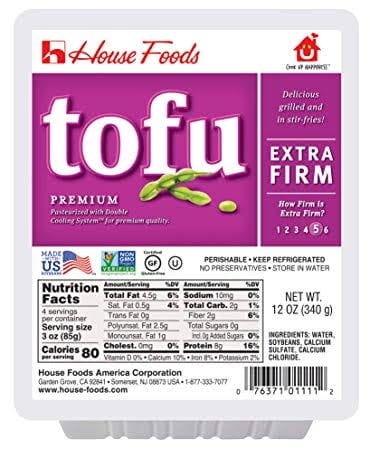
Tofu, also known as bean curd, is a versatile protein source made from soybeans. It’s a staple in many Asian cuisines and a popular ingredient in vegetarian and vegan diets. Tofu is made by coagulating soy milk and pressing the resulting curds into solid blocks. Its mild flavor and ability to absorb other flavors make it an ideal ingredient for a variety of dishes, from savory to sweet.
In our Baked Tofu and Vegetable Stir-Fry, tofu provides a firm, protein-rich base that pairs beautifully with a medley of fresh vegetables. This dish aligns with the Blue Zone focus on plant-based foods, offering a delicious and nutritious way to incorporate more plant proteins into your diet. Tofu is not only low in calories but also a great source of essential amino acids, iron, and calcium, making it a valuable addition to a balanced diet aimed at promoting longevity and well-being.
How do you bake tofu?
Baking tofu is a fantastic way to add texture and flavor, making it a perfect addition to stir-fries. To start, preheat your oven to 400°F (200°C). Drain the tofu and press it to remove excess moisture. We don’t own a tofu press, but this can be done by wrapping the tofu in a clean kitchen towel and placing a heavy object on top for about 15 minutes. (I typically use a bowl of tangerines we leave on the counter for snacking.) Once pressed, cut the tofu into cubes approximately 1” x 1.5” x .5”.
In a bowl, toss the tofu cubes with a bit of olive oil, soy sauce, and cornstarch. The cornstarch helps to create a crispy exterior. Spread the tofu cubes on a baking sheet lined with parchment paper, ensuring they are in a single layer. Bake for 25-30 minutes, flipping halfway through, until the tofu is golden and crispy.
[Alternative: use a pre-made sauce like Soy Vey Very Teriyake! Just go easy because this stuff has sugar.]
Baking tofu this way enhances its texture, giving it a delightful crunch that contrasts nicely with the stir-fried vegetables. This method aligns with the Blue Zone philosophy by using minimal oil and enhancing the natural flavors of the ingredients.
By incorporating baked tofu into your stir-fry, you’re adding a protein-rich element that supports muscle health and overall well-being, essential components of a longevity-focused diet.
What vegetables are best for baked tofu stir-fry?
The beauty of a stir-fry lies in its versatility. You can use a wide variety of vegetables, depending on what’s in season or your personal preferences. Some great options include bell peppers, broccoli, snap peas, carrots, and mushrooms. These vegetables not only add vibrant colors to the dish but also provide a range of nutrients, including vitamins, minerals, and antioxidants.
When we don’t have time to prepare the veggies, I’ll microwave a frozen bag of a vegetable medley that includes water chestnuts. Seriously, this couldn’t be easier. Heat them up, then lightly stir fry them as if they were fresh.
If you do have the time to prepare veggies, I recommend a mix of bell peppers, broccoli, snap peas, carrots, and water chestnuts. These vegetables maintain their crunch during the quick stir-fry process, adding both texture and flavor to the dish. Stir-frying is a method that preserves the nutritional content of the vegetables, making it a great choice for a healthy meal.
This combination of vegetables aligns with the Blue Zone principle of eating a variety of plant-based foods to ensure a broad spectrum of nutrients. Each vegetable contributes its unique set of vitamins and minerals, supporting overall health and well-being. By including a diverse range of vegetables in your stir-fry, you’re not only making the dish more interesting but also embracing a dietary practice that promotes longevity.
What sauces are good for stir-fry?
A good stir-fry sauce is essential for bringing together the flavors of your ingredients. Common ingredients for a stir-fry sauce include soy sauce, sesame oil, garlic, ginger, and a bit of sweetness from honey or maple syrup. For a spicy kick, you can add some chili paste or Sriracha.
In our Baked Tofu and Vegetable Stir-Fry, I use a simple yet flavorful sauce made from soy sauce, sesame oil, minced garlic, and freshly grated ginger. This combination enhances the natural flavors of the tofu and vegetables, creating a harmonious and delicious dish. The sauce is light yet packed with umami, making it a perfect match for the baked tofu and crunchy vegetables.
This sauce aligns with the Blue Zone focus on using simple, whole ingredients to create flavorful meals. By avoiding overly processed sauces and sticking to basic, wholesome ingredients, you can enjoy a delicious meal that supports overall health and longevity. This approach not only makes the dish taste great but also ensures that it remains aligned with the principles of a healthy, Blue Zone-inspired diet.
Let’s cook a baked tofu stir-fry!
This Baked Tofu and Vegetable Stir-Fry combines the best plant-based ingredients in a delicious, nutritious meal. Crispy baked tofu pairs perfectly with vibrant, crunchy vegetables, all complemented by a simple yet flavorful sauce. This dish is a wonderful example of how healthy eating can be both satisfying and enjoyable, embodying the principles of a Blue Zone-inspired diet.
Baked Tofu and Vegetable Stir-Fry
4
servings15
minutes30
minutes309
kcalA simple, fresh tofu stir-fry recipe inspired by the plant-based eating habits found in Okinawa, a notable Blue Zone region.
Keep the screen of your device on
Ingredients
14 oz (1 block) Extra firm tofu, pressed and cubed
2 Tbsp olive oil, divided
2 Tbsp soy sauce, divided
1 Tbsp cornstarch
1 red bell pepper, sliced
1 yellow bell pepper, sliced
2 cups broccoli florets
1 cup snap peas
1 large carrots, sliced or julienned
3 cloves garlic, minced (or equivalent)
1 Tbsp fresh ginger, grated
2 Tbsps sesame oil
1 Tbsp honey or agave (optional)
salt and pepper to taste
Directions
- Preheat your oven to 400°F (200°C).
- In a bowl, toss the tofu cubes with 1 tablespoon olive oil, 1 tablespoon soy sauce, and cornstarch. Spread the tofu on a baking sheet lined with parchment paper and bake for 25-30 minutes, flipping halfway through, until golden and crispy.
- While the tofu bakes, heat the remaining 1 tablespoon olive oil in a large skillet or wok over medium-high heat. Add the garlic and ginger, sautéing for 1-2 minutes until fragrant.
- Add the bell peppers, broccoli, snap peas, and carrots to the skillet. Stir-fry for 5-7 minutes until the vegetables are tender but still crisp.
- In a small bowl, mix the remaining 1 tablespoon soy sauce, sesame oil, and honey or maple syrup, if using. Pour the sauce over the vegetables, stirring to coat evenly.
- Add the baked tofu to the skillet, tossing to combine with the vegetables and sauce. Cook for another 2-3 minutes to heat through.
- Season with salt and pepper to taste. Garnish with fresh cilantro or green onions before serving.
Notes
- Short on time? Use a bag of frozen vegetables and save time on prep. Heat them in the microwave first, and then be careful not to overcook them in the wok.
Nutrition Facts
- Total number of serves: 4
- Calories: 309kcal
- Carbohydrates: 22.2g
- Protein: 13.3g
- Fat: 19.7g
- Saturated Fat: 2.7g
- Polyunsaturated Fat: 6.6g
- Monounsaturated Fat: 8.8g
- Trans Fat: 0g
- Cholesterol: 0mg
- Sodium: 487.5mg
- Potassium: 384.6mg
- Fiber: 6.7g
- Sugar: 8.7g
Like this recipe?
Follow @fitnrdco on Pinterest
Join our Facebook Page!
Follow FITNRD on Facebook
